The drive north to "Trulliland" was reasonably short and we arrived before midday even though we had stopped for a coffee en route . We were met by our landlady [Ana] who did her best to bridge the language barrier [she with no Inglese and we with beginner Italian – probably kindergarten Italian or even the level of learning before that]. However, the trusty iPhone translation app was pressed into service and we got through reasonably unscathed [with one exception].
Towards the end of the check-in process, she started to explain about bringing us something in a couple of days' time. It got a bit confusing because Stu thought it was going to be a cake and Trish thought it was going to be bread. However, we were very clear that it would arrive about 8.00 pm two nights hence. Well, two nights later, we decided we would eat early [7.00 pm] so that the dishes were cleared by the time that the cake/bread arrived. The cake/bread duly arrived at the appointed time – cake, bread, four different types of pizza, Roast chicken and potatoes, mashed potatoes and turnip greens, together with two bottles of the family’s home-trodden wine . And we got the clear impression that it was supposed to be our dinner that night. We were glad that we had cleared our dinner dishes away and even gladder that they decided not to stay while we ate the feast. We were particularly glad that they did not decide to crack one of the bottles of wine because having sampled the one that Ana had left for us on Day 1, we didn't feel inclined to revisit the experience. However, one could not fault the generosity. Needless to say, it all went into the fridge [except for the wine which was used later for cooking].
The outside vertical walls of our Trulli house are about six feet thick and are constructed of the local soft limestone. The conical roof is built in three separate layers; limestone blocks to form the cone, smaller rocks to give added insulation then the large slate-like rock to form the outer water-shedding layer. Inside, walls are whitewashed/weathered limestone and the floor is flat[ish] irregular limestone blocks . Hard to tell the age of the one that we had because the electrical work and plumbing had been retrofitted [grooves cut in the soft limestone and then re-plastered with white cement.] All very rustic but extremely comfortable. Trish had been looking forward to this stopover largely because of the experience of living in a Trulli house. We were definitely not disappointed.
No one actually knows for sure when Trulli houses were conceived but documented history indicates they have certainly been around for 2000 years at least, with the name traditionally applied to ancient round tombs found in the Roman countryside. With few forests in this part of Italy and the ready availability of stone, it is not surprising that the locals opted for that as the main construction material. The fields are full of loose rocks which keep working to their way to the surface, even in the more established cropping areas. And the stone is put to good use. The roads are lined with hand laid stone walls, the farm fields are lined with stone walls and most of the local farm houses in this area [well, those that are over a hundred years old] are stone .
It had been pointed out to us earlier in the journey that electricity was expensive in Italy, with the bulk of it generated from fossil fuels. We have noted, however, that they are attempting to do something about reducing their reliance on such an expensive form of generation and moving to more sustainable forms - wind & solar farms. From Abruzzo south, we have passed many wind farms [like Palmerston North’s]. However, the turbines appear to have very large blades, certainly larger than we have in NZ. Likewise there are lots of solar panel farms; while this was an expensive form of generation 20 years ago, it is now cheaper than using diesel generation plants.
We mentioned in our last report, the influence of Greece in the architecture of the region. It is particularly noticeable here around Ceglie Messapica in the Valle d’Itria. While Ostuni has been singled out by UNESCO as a World Heritage site, it is only one of a number of citta bianche [white cities] located in this area . The Greek influence dates back to “Magna Graecia”, that part of the then world falling under Greece’s control between the 8th - 3rd centuries BC. That influence is present today in the architecture, the whitewashed towns, the food and even some parts of the local dialect. Puglia has been a bit of a sponge having taken on board a bit from every culture that has rolled over the area - Greek, Saracen, Norman and Aragonese, Turk – if they have been here, they have left something behind. The Normans and the Aragonese, in particular, left forts wherever they went and, fortunately, a number of these are still preserved today [even if they are invariably closed on the day we choose to visit]. However, while other conquerors have since come and gone, the "Greekness" of the region prevails. Not surprising, as here they are closer to Greece [just over 100 kms] than they are to Rome.
While the region has experienced a long-lasting Greek influence, the golden age of Puglia’s past was under the rule of the Normans, followed by Frederick II who, between his return from Germany as emperor in 1220 and his death 30 years later, only spent four years away from the region . In that time, he built many castles, some spectacular and others unusual. None of the latter more so than Castel del Monte, an octagonal castle which reportedly was then not used. It apparently did not even have a kitchen so maybe it would have been better known as "Frederick's Folly".
Our Trulli house is about three kms outside Ceglie Messapica - our local town -so not a simple walk down to the corner shop to pick up the milk. Ceglie Messapica, with its ancient Eastern features, is one of the oldest towns in Puglia. Its name is associated with the Messapians, the ancient people of Puglia who inhabited the area well before the Romans popped up on the scene. For the Messapians, Ceglie was an important military post and featured in a major battle with the team from Taranto [further to the west] who were after access to the Adriatic. Following a spell under the Romans, it then fell away in importance in the Middle Ages. It regained some of its earlier importance in the 14th/15th Centuries when the city was again fortified, this time incorporating the earlier Norman fort . There are many masseria [fortified villas] in the area, some of which have re-roled themselves as agriturismos. As indicated in an earlier report, agriturismos must meet set standards and be working farms to gain the agriturismo subsidy. Ceglie Messapica’s modern reputation ensues mainly from its excellent cuisine, which specialises in ancient flavours and recipes. Ceglie also has an academy of gastronomy, underlining the part that food plays in the development of the town's reputation.
We have been avoiding the main centres of Puglia [Bari, Brindisi, Taranto] during our stay here in order to get a better feel for the countryside. For us, the two towns best characterising this area were Ostuni [the jewel in the "citta bianche" crown] and Alberobello, the Trulli capital.
We first saw Ostuni as we drove in from the coast on our way north from Castro. It really stands out from a distance... Is it a white marble quarry ...no. ..it is houses...but they are all white like cotton-wool...then it drops behind the olive trees as we start to drive through the groves ...and then suddenly, it reappears...sitting atop its rise in all of its splendour. A magical city. According to some, the town’s name derives from the Greek word Astuneon [meaning new city]. It has been established, however, that the city was originally settled by the Messapians and was then conquered by the Romans, the Byzantines, the Lombards and then the Saracens before the Angevins [French] and the Aragonese [Spanish] joined the party only to be then pushed out by the Duchy of Bari. The old town of Ostuni forms a ring around the old cathedral, from whence the narrow streets and staircases start, often featuring arcades that then lead back to the top of the hill. The city is almost deserted out of season; even on the shoulder of peak season, however, there were still a few "follow me" groups trying to muscle in on your photo shot.
A further big plus for us with Ostuni apart from being a lovely city was the great restaurant that we found for lunch on our first visit [we went back to the town several times] . We had a parmigiana e melanzane antipasti and plate of orecchiette [fresh hand-made "little ears" of pasta] with anchovy and broccolini. Absolutely delicious. The topping on the orecchiette was grated stale bread which had been tossed over heat with olive oil until it was dry and crisp. This was a substitute for Parmesan because in bygone days, Parmesan was an expensive commodity. The further surprise was the camaraderie that was displayed by those in the restaurant. There was an older couple with their daughter [late 40s] who were Italian but for the past 40 years had lived in South Africa, the daughter's old English school chum, an Italian couple, an Italian guy by himself and us, who understood little Italian but were dragged into the discussion because we were sitting at the next table to the family who would slip into Inglese every now and then. By the end of the meal, three way conversations were the order of the day with the bilinguals filling in the gaps. Once the others had left [we were the last to leave], we were invited out to the kitchen to see how the bread substitute was made . A very special day.
Sticking with the food for a moment, we have noted that Puglian food tends to favour the simple. Traditionally, Puglia has been a poor region and produce such as eggs and cheese were considered to be luxuries. Consequently, meals tended to include inexpensive alternatives to such scarce commodities... the grated bread toppings instead of parmesan, and the pasta not being made with eggs.
Finally, the wi-fi - we found free wi-fi here...well, free as long as you bought a coffee (or a spritz). Having no easy access to the Internet was a bit of a challenge as this week we needed to deal with some rather urgent business on the home front and required access to printer, scanner etc. The ONLY downside to our jewel of a home here was that cell phone coverage was intermittent and it had no wi-fi so only means of communication from the trulli was text/email [when service allowed] from the cell phone . Ceglie Messapica doesn't have a hotspot anywhere in the town, hence, our desire to find hotspots in our forays away from home base.
Alberobello dates back to the 12th Century and is a bit like a fairytale village. Suspect that this place must have been high on Peter Jackson's locations list if he had had much more trouble with the actors' union back home. The place is quite surreal and had we not actually been living in a trulli at the time we visited Alberobello, we would have had difficulty believing it was not part of a Hollywood set. The town has about 1,000 trulli and it is on UNESCO's list of World Heritage Sites. Many of the trulli in the lower part of the town are souvenir shops together with trulli restaurants, retail shops, and even a trulli church. However, there is only one two-storey trulli; it dates back to the 18th century and was built for the local priest. Nowadays, it is a museum dedicated to the trulli.
Other towns included on our day trip were:
- Locorotondo. Its name [translated as "round place"] gives you a clue to its appearance. With streets arranged in concentric circles, the town is made up of low-built, whitewashed houses in a walled enclave atop a hill. Little is known about Locorotondo’s origin, however, it first gets mentions in the late 12th Century. It was certainly part of the Taranto principality during the 15th Century before passing to the Dukes of Martina Franca two centuries later. Another of the citta bianche. Also a nice lunch stop as the rain again threatened. A very special town.
- Oria...what can we say. Probably the area's oldest town that [according to historians] was founded by a bunch of shipwrecked Cretan sailors [seas must have been of tsunami proportions because Oria is about 20 km inland.] The town eventually became the capital of the Messapians. The usual suspects then replaced each other over the ages until Frederick II arrived and decided to build ... you guessed it, his speciality...a castle. It was so good that the successive rulers and other forms of management took up residence in it and progressively modified, updated and upgraded it over the centuries. In the 16th Century, the whole town of Oria was owned by the Borromeo [we had come across this family in Mercallo], who sold it to the Imperiali. These were seriously rich people. The old town still retains much of its medieval form with its steep slopes and a warren of narrow streets and steps. But the fort [albeit still in the hands of yet another reasonably wealthy family] still stands silent guard over the town. They were filming a TV programme [modern fiction] around the Douma piazza when we visited.
- Mesagne is positioned on the last significant hill before the land rolls out onto the Salento plains area that we had tripped around during our previous stop. The town was originally positioned to maintain control of the ancient road between Brindisi and Oria. Archaeologists have established that it was occupied by the Messapians around the 4th Century BC. They were followed by the Romans, the Byzantiums, the Saracens, the Normans [11th Century] before the town was completely destroyed by the Swabians in the 13th Century. Two centuries later, the Angevins rebuilt the castle and restored the walls and the cycle of change management started again. So in that sense, Mesagne is very similar to most other old Italian cities. Today, its splendid castle and some very old churches, most being constructed between the 13th and 17th centuries, serve as reminders of the high and low points of its past.
- Manduria is a large farming town well known for the production of olive oil and wine, in particular, our favoured Primitivo grape. Back in the day in ancient Magna Graecia, the town was a fierce enemy of Taranto [then a major Greek outpost] and it successfully defeated the King of Sparta in the 4th Century BC. However, it was not so fortunate when Hannibal arrived a century later. The Romans then had their slice of the action before the town was finally destroyed by yet another unruly visitor in the 6th Century. Rebuilt in the late 11th Century, Manduria is another Italian city rich in history. However, all of that paled into insignificance in the blink of an eye because we found that it had a cafe which was the only free wi-fi spot within 30 kms. Knew there had to be a good reason to include it on the day trip (other than to pay homage to the mighty Primitivo di Manduria).
Finally, returning to our Trulli home, it had one main room with two alcoves off that for sleeping areas [each not much more than a king size bed], a kitchen area with open fireplace, and a bathroom area. Each of the areas [excluding the bathroom] had its own characteristic Trulli dome. The kitchen is completely separate with its own entrance from the outside, and along with the electric stove has a wood fired oven. One morning before we set out to check out the local area, the landlady's aunt and uncle appeared to do some work of the olive trees . They apparently had a farm on a separate block further down the road. We had an animated conversation - one side in Italian and the other in English. Again, the trusty cell phone translation app was pressed into service on the parts where we could not follow the gestures. We [and probably they] have no idea if the conversation was translated correctly.
The farm produces a variety, with crops visible from our little trulli including olives, grapes, pomegranates, figs, vegetables [such as chicory, aubergine, and tomatoes], quinces, apples, lemons, limes, peaches, cherries, black currants, almonds and even walnuts. In fact, we sampled walnuts fresh from the tree and they were really sweet, creamy and extremely tasty. Much better than the store bought variety. We had also been wondering about a low growing shrub in the garden and Uncle/Aunty informed us that it was caper-berry, and we managed to find two still on the bush.
Well, time to say ciao ciao to our cute little rustic home and head on to Calabria, the toe of the boot . Puglia has been "Trulli" different and exceeded our expectations. While the real south of Italy that we have visited thus far - Abruzzo, Molise, and Puglia (with Basilicata and Calabria yet to come) - has literally been the poor cousin over the ages, they are slowly coming into their own in terms of cuisine, wines and their economy. Traditionally, Puglia wasn't one of the wealthy states, however, when it comes to the food side, they produce innovative alternatives where something is either expensive or in short supply. The result, some of the best, if not the best cuisine we have had thus far. As far as the people are concerned, they were generally interested more in the discussion rather than the transaction. Our advice is, get here for a visit soon otherwise the tourist crush will ruin the experience.

 Ceglie Messapica, Puglia, Italy
Ceglie Messapica, Puglia, Italy

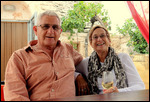







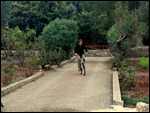


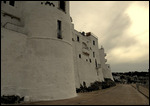





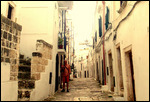

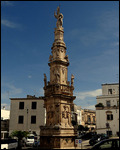


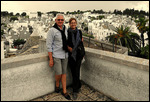
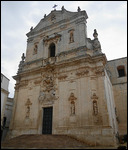
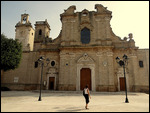
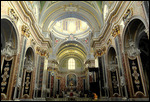
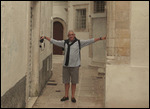

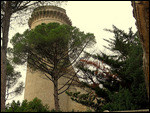
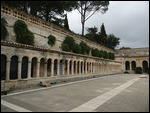


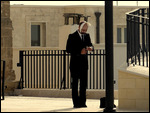
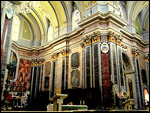
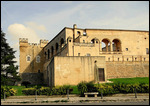

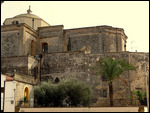



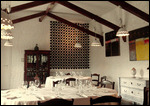
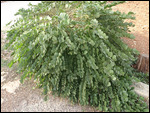
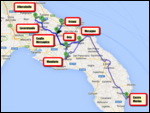
2025-05-23